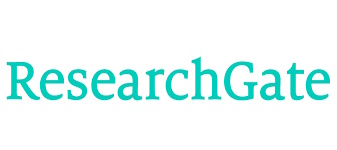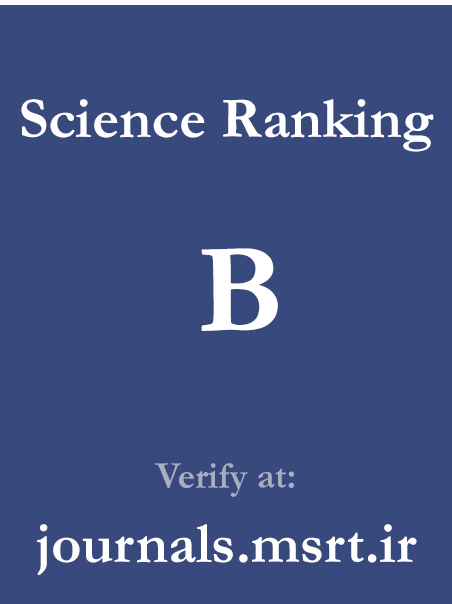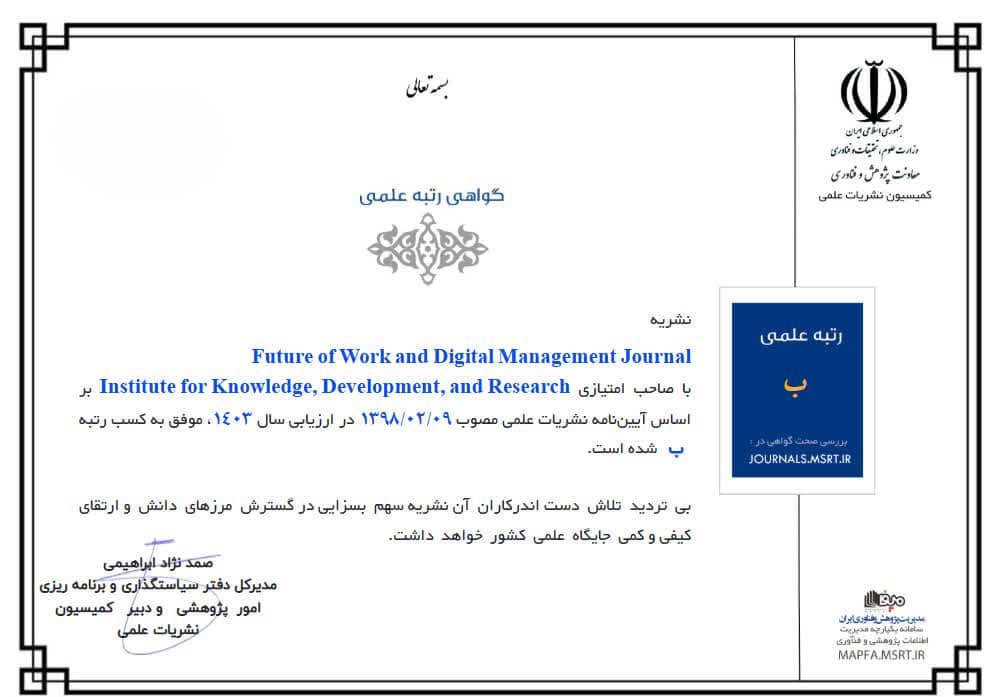Examining the Impact of Antecedents and Consequences of the Organizational Structure Agility Model in the Ministry of Industry, Mine and Trade
Keywords:
Organizational Agility, Mine and Trade, Organizational Structure , Structural Equation Modeling, Factor Analysis, Ministry of IndustryAbstract
Organizational structure agility, as one of the influential factors in improving the performance of public organizations, requires a thorough examination of the variables affecting it. The purpose of this study was to design and test a model for enhancing organizational structure agility in the Ministry of Industry, Mine and Trade using quantitative methods. To this end, based on a review of the research literature and previous studies, the dimensions and key components of organizational structure agility were first identified. Subsequently, by developing a questionnaire and collecting data from 131 managers and experts of the Ministry, confirmatory factor analysis and structural equation modeling were used to examine the relationships among the variables. The findings indicated that the designed model consists of four main dimensions: structural agility requirements, outcomes and consequences, facilitating factors, and barriers to structural agility. The analysis results showed that agility requirements have a positive and significant effect on organizational outcomes, while structural barriers can weaken this relationship. Accordingly, suggestions were provided to improve the organizational structure agility of the Ministry.
Downloads
References
[1] Y. Y. Yusuf, M. Sarhadi, and A. Gunasekaran, "Agile manufacturing: The drivers, concepts, and attributes," International Journal of Production Economics, vol. 62, no. 1-2, pp. 33-43, 2022, doi: 10.1016/S0925-5273(98)00219-9.
[2] S. K. Jalali and R. Rahman Seresht, "A Pathological Study of Organizational Structure (Agricultural Jihad of Kurdistan Province)," in Fourth International Conference on Applied Research in Management and Accounting, 2017.
[3] S. M. Ahmadi Baladehi and E. Babaei Kachabi, "Investigating the Impact of Organizational Structure on Organizational Agility in NAJA (Law Enforcement Force of Mazandaran Province)," Quarterly Journal of Police Organizational Development, no. 63, 2018.
[4] F. Almazrouei, A. E. Sarker, P. Zervopoulos, and S. Yousaf, "Organizational Structure, Agility, and Public Value-Driven Innovation Performance in the UAE Public Services," Heliyon, 2024, doi: 10.1016/j.heliyon.2024.e33261.
[5] A. Garshasbi and S. Dadashi, "The System of Issues and Challenges of the Industry, Mine, and Trade Sector on the Eve of the Seventh Development Plan," Business Reviews, vol. 21, no. 122, pp. 33-48, 2023.
[6] M. Xu, Y. Zhang, H. Sun, Y. Tang, and J. Li, "How Digital Transformation Enhances Corporate Innovation Performance: The Mediating Roles of Big Data Capabilities and Organizational Agility," Heliyon, 2024, doi: 10.1016/j.heliyon.2024.e34905.
[7] X. Zhu and Y. Li, "The use of data-driven insight in ambidextrous digital transformation: How do resource orchestration, organizational strategic decision-making, and organizational agility matter?," Technological Forecasting and Social Change, vol. 196, p. 122851, 2023, doi: 10.1016/j.techfore.2023.122851.
[8] M. Atienza-Barba, M. D. L. C. del Río, Á. Meseguer-Martínez, and V. Barba-Sánchez, "Artificial intelligence and organizational agility: An analysis of scientific production and future trends," European Research on Management and Business Economics, vol. 30, no. 2, p. 100253, 2024, doi: 10.1016/j.iedeen.2024.100253.
[9] R. Dove, Response Ability: The Language, Structure, and Culture of the Agile Enterprise. John Wiley & Sons, 2020.
[10] S. L. Goldman, R. N. Nagel, and K. Preiss, Agile Competitors and Virtual Organizations: Strategies for Enriching the Customer. Van Nostrand Reinhold, 2019.
[11] H. Sharifi and Z. Zhang, "A methodology for achieving agility in manufacturing organizations: An introduction," International Journal of Production Economics, vol. 62, no. 1-2, pp. 7-22, 2023, doi: 10.1016/S0925-5273(98)00217-5.
[12] M. Peuser, "Agile Organizational Concepts for Retail Companies in Times of Digitalization: Design and Management of Agile Organizational Structures for More Competitiveness in the Face of Changing Customer Needs," in Multisensory in Stationary Retail: Principles and Practice of Customer-Centered Store Design. Wiesbaden: Springer Fachmedien Wiesbaden, 2023, pp. 399-421.
[13] H. Varmzyari, M. Babaei, and H. Sardar Shahraki, "An Analysis of the Challenges of Governmental and Non-governmental Structures in the Agricultural Sector and the Provision of Reform Solutions," in Eighth National Congress of Agricultural Extension and Education, Natural Resources, and Sustainable Environment, 2020.
[14] S. Khalil and T. J. Winkler, "How software as a service simultaneously affords organizational agility and inertia," The Journal of Strategic Information Systems, vol. 32, no. 4, p. 101804, 2023, doi: 10.1016/j.jsis.2023.101804.
[15] Ö. B. Yağmur and N. A. Myrvang, "The effect of organizational agility on crisis management process and organizational resilience: Health sector example," International journal of disaster risk reduction, vol. 96, p. 103955, 2023, doi: 10.1016/j.ijdrr.2023.103955.
[16] H. Rahbar, M. Aghaei, and R. Aghaei, "Presenting a Conceptual Model of Organizational Agility," Quarterly Journal of Technology Development, vol. 10, no. 39, 2021.
[17] M. A. Arokodare and B. R. Falana, "Strategic agility and the global pandemic: The agile organizational structure, a theoretical review," Information Management and Business Review, vol. 13, no. 1, pp. 16-27, 2021, doi: 10.22610/imbr.v13i1(I).3145.
[18] A. Chwiłkowska-Kubala, S. Cyfert, K. Malewska, K. Mierzejewska, W. Szumowski, and G. Prause, "What drives organizational agility in energy sector companies? The role of strategic CSR initiatives and the dimensions of proactive CSR," Sustainable Futures, vol. 6, p. 100133, 2023, doi: 10.1016/j.sftr.2023.100133.
Downloads
Published
Submitted
Revised
Accepted
Issue
Section
License
Copyright (c) 2025 Maryam Rezaei Shahsavari, Mohammad Hasan Maleki, Mohammad Reza Soltani (Author)

This work is licensed under a Creative Commons Attribution-NonCommercial 4.0 International License.







